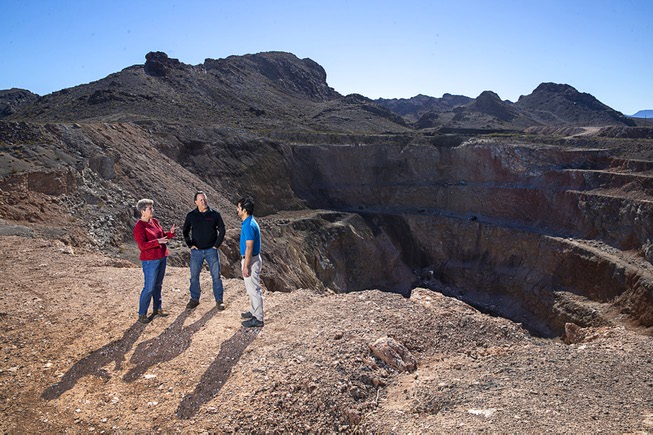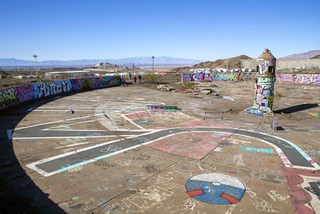
Mindy Unger-Wadkins, left, project manager at Unger Development, Kirk Stowers, center, principal geologist with Broadbent and Associates Inc., and Alan Pineda, an engineer specializing in industrial site cleanup with the Nevada Department of Conservation and Natural Resources, talk by the Hydro Pit at the Three Kids Mine Wednesday, Nov. 8, 2023, in Henderson. The open-pit manganese mine operated from 1917 to 1961.
Sunday, Nov. 12, 2023 | 2 a.m.
To the south of Lake Las Vegas, just past Lake Mead Boat Storage off Lake Mead Parkway, lies a paradise of graffiti and dirt.
There are couches littered with graffiti and firework cartridges, with names such as “Addicted to Quack.” And as you walk, it’s a challenge to avoid the broken glass and bullet casings.
The dirt lot is accessed by a narrow opening between concrete barriers covered in, you guessed it, more graffiti.
This area is the abandoned Three Kids Mine.
It has sat in this condition since the 1960s but could soon become a master-planned housing development of 3,000 homes. The transition will be accomplished through a unique private-public partnership between Lakemoor Ventures LLC, the city of Henderson and the Nevada Division of Environmental Protection.
According to the project’s website, a redevelopment zone has been created, allowing for the allocation of future Lakemoor residents’ property taxes over a 45-year period to pay for the cleanup of the former mine grounds. The partnership is unique because it addresses the funding dilemma of homebuilders not wanting to pay for cleanup costs, developers said.
It also speeds up the timeline for cleaning up the property. One alternative, seeking a federal declaration making the site eligible for the Environmental Protection Agency’s Superfund cleanup, couldtake several decades.
Superfund cleanups across the U.S. are done “in order of priority and this would be a low priority,” said Mindy Unger-Wadkins, the project manager at Lakemoor Ventures. “So it would be decades before the federal government would touch it, as opposed to getting it done now with this mechanism.”
The story began in 1917 when manganese ore, a key ingredient in the production of iron and steel, was found here. The site was mined off and on until 1961, when the land was sold.
In 1963, the land was abandoned, and illegal dumping from outside entities began afterward. This can be seen at the site in the form of old cars pushed down into the pit. There has also been some asbestos illegally dumped at the site from outside sources, with only a portion of the asbestos being original to the mining facility.
Alan Pineda, a project manager with Nevada Division of Environmental Protection who is overseeing the cleanup, said the department’s priority was to guard public health.
“So we can’t just have a contaminated site sitting out here with contaminants unaddressed,” Pineda said.
Pineda’s concerns for the site include three open pits, piles of waste rock and tailings. The tailings can be seen at this site in the form of a large field of dark mud, which is contaminated. The area is contaminated with asbestos and metals, including lead, arsenic and manganese.
The site is not open to the public, but trespassing is common, he said. Trespassers’ safety, Pineda said, could be compromised, for instance, if they fell into the pits or kicked up some metal-infused dust and inhaled it.
In 2007, Unger-Wadkins’ brother Bob Unger started what is now the Lakemoor Ventures project, which is a public-private partnership. The unique mine remediation strategy that would bring about the development required an act of Congress. Unger-Wadkins said the BLM recommended seeking legislation for the project to give it the appropriate level of priority.
In 2014, the Three Kids Mine Remediation and Reclamation Act, which authorized the project, was signed into law.
HR 697, or the Three Kids Mine Remediation and Reclamation Act, requires the BLM to sell 950 acres of federal land, some of which are contaminated by hazardous waste, to the city of Henderson.
“It was a nonpartisan piece of legislation,” Unger-Wadkins said. “Nonpartisan, noncontroversial and all six (of Nevada’s federal) delegates were signed onto it.”
Unger-Wadkins said they got Nevada Senate Bill 297 in 2015 as well, to secure their current plan of utilizing 45 years’ worth of property taxes when the default would be 30.
The project is working with Pulte Homes, which Unger-Wadkins describes as “the third-largest national homebuilder in the country.” Aside from adding more housing to the Las Vegas metropolitan area, this project also has the potential to set a precedent for future mine clean-ups elsewhere.
Of her experience discussing the project with Congress, Unger-Wadkins says, “Everybody kept talking about, ‘Boy if this works, we could do this in other states.’ ”
Kirk Stowers, a geologist with Broadbent & Associates, was tasked with characterizing the contamination of this site and planning for its remediation. Stowers and his company gathered over 900 samples from this site.
“And perhaps most importantly, we determined that the contamination on this site is not going to leach in any appreciable way down to the groundwater,” Stowers said.
Stowers describes the planned cleanup process, in which the “adequately encapsulated” contaminated tailings will be dumped into the pit they’ve dubbed “Hydro Pit.” Next, they will add some comparatively cleaner displaced rock and soil material, followed by an “engineered liner” and a storm drain that will allow for future development.
Unger-Wadkins emphasizes that no homes will be built on top of these converted pits, but they are instead planning for a community park. She estimates the tailings cleanup will begin in spring or summer of 2024 and last about a year.
The immediate next steps for Lakemoor Ventures are two back-to-back meetings Nov.21. The first is with Henderson’s Redevelopment Agency to sign an owner participation agreement, which establishes the timeline and specific money amounts for paying back the cleanup costs. Next, they will meet with the Henderson City Council to sign a development agreement to establish the architectural details of the master-planned community. They intend to have the grand opening of their first homes in early 2026.
Until then, trespassers will make their regular visits.
On this windy November day, as the team of environmental professionals and a developer wrap up their explanation of plans for this site, a few stray trespassers slide in through the narrow opening between concrete barriers covered in graffiti.
Many head this way to see the “Wheel of Misfortune,” an estimated 300-foot art installation painted on an existing flotation cell about 10 years ago that consistently brings visitors to the site. It’s easily spotted by planes flying overhead, and has messages such as “lose a home,” or “lose all hope.”
But for some, the site could be where they gain a home.

